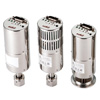Vacuum
The word “vacuum” may evoke an image of a space which contains nothing, but more accurately it is the state of a space where the pressure is lower than atmospheric pressure.
- Pressure in a vacuum is below atmospheric pressure, and a vacuum is not a space where there is nothing.
- Many advanced technologies in everyday life come from improvements in vacuum technology.
- Different technologies are used to create the right vacuum level for the application.

Pressure in a vacuum is below atmospheric pressure, and a vacuum is not a space where there is nothing.
We often think of a vacuum as a state in which there is no air, no pressure, and no anything. In reality, however there is no space where nothing exists. Even outer space outside the Earth’s atmosphere, which is generally considered to be a vacuum, is not absolute nothingness, although there is no air there.
Even if you do not fly to outer space, there are vacuums all around you. According to the definition of the Japanese Industrial Standards (JIS), the term vacuum refers to the “state of space filled with gas at a pressure lower than normal atmospheric pressure.” Such a state can actually be experienced at any high place like the top of Mt. Fuji.
The air pressure on the plains where most people live is 1 atm or 1013 hPa (hectopascals = hundreds of pascals). Atmospheric pressure decreases by about 1 hPa as the altitude increases by 10 meters, up to several thousand meters, so the atmospheric pressure drops to about 630 hPa at the top of Mt. Fuji at an elevation of 3,776 meters. At the top of Mt. Fuji where the atmospheric pressure is about two thirds of the atmospheric pressure at ground level, phenomena different from those seen in a 1 atm environment can be experienced, such as difficulty in catching one’s breath because of the thin oxygen, and the ability to boil water at about 20 ℃ lower than at sea level.
Many advanced technologies in everyday life come from improvements in vacuum technology.
Vacuum technology is used everywhere, contributing to the improvement of industrial technology and everyday life. Examples are the replacement of the gas in fluorescent lights, vacuum deposition to manufacture mirrors for automobiles, distillation of distilled liquors, suction used to pack eggs in egg packs, and so on.
The progress in vacuum technology that made it possible to create high-level vacuums that do not have even the slightest amount of impurities has contributed to the evolution of semiconductor devices such as microcomputers and flash memories. Vacuum technology also plays a large role in increasing memory capacity, utilizing big data for advanced computation, achieving Artificial Intelligence (AI), and making improvements on many other fronts.
Different technologies are used to create the right vacuum level for the application.
According to the classifications defined by JIS, a space filled with gas at the pressure found at the top of Mt. Fuji is a “low vacuum.” Higher levels of vacuum are “medium vacuum,” “high vacuum” and “ultra high vacuum.” The level of vacuum in outer space is even higher than ultra high vacuum.
Different levels of vacuum are used for specific purposes. Examples are low vacuum for oxidation prevention and vacuum insulation, and high vacuum for semiconductor processing.
The simplest way of making a vacuum is to suck air out of a container using a vacuum pump or the like. When an ultra high vacuum is required for ultrafine semiconductor processing, for example, the air in the manufacturing area is sucked out to a certain extent, and then turbomolecular pumps are used to blow even small molecules to the outside of the area with high-speed rotating blades.
Vacuum gauges for high-precision measurement of the vacuum states inside vacuum chambers have evolved along with vacuum technology. The technology for creating, using, and measuring vacuums has evolved in tandem. As a result, various manufacturing technologies have improved, contributing to the development of our modern information-oriented society. If vacuum technology evolves further in the future, we can expect the birth of technologies and products that we have never seen before.

